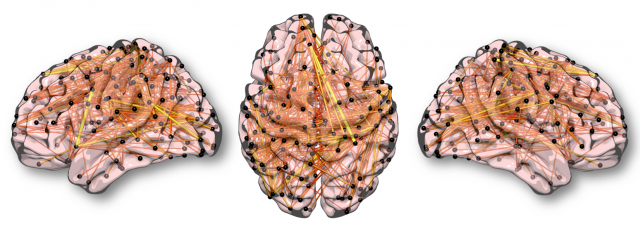28 and Me
Neuroimaging studies typically describe properties of the brain through group-averaged, cross-sectional designs. Network neuroscience has moved towards densely sampling individuals to probe the dynamic properties of the human brain over time. To date, these models have overlooked the influence of sex hormones on intrinsic brain networks. This is surprising, given that the brain is an endocrine organ and hormonal effects on the central nervous system can be measured across multiple spatio-temporal scales. Across a typical menstrual cycle (occurring every 25-30 days), naturally cycling females experience a ~8-fold increase in estrogen and an ~80-fold increase in progesterone.
"28andMe" is a dense-sampling, multimodal brain imaging study probing the extent to which endogenous fluctuations in sex hormones across a complete reproductive cycle -28 days- alter functional connectivity of brain networks at rest. Daily time-locked blood draws and sMRI/fMRI scans were acquired across 30 consecutive days. Dynamic community detection and time-lagged vector autoregression models revealed that estradiol drives greater functional coherence across much of the brain's cortical surface, particularly in estrogen-receptor (ER)-rich brain networks (e.g. Default Mode, Frontoparietal).
Next, we used high resolution hippocampal subfield imaging to examine the relationship between sex hormones and medial temporal lobe morphology. We found that unique subfields of the human hippocampus and surrounding medial temporal lobe are impacted by fluctuating sex hormones across the 28-day cycle. These results establish sex hormones’ ability to rapidly and dynamically shape medial temporal lobe morphology across the human menstrual cycle.
A follow-up study "28andOC" was conducted to investigate the impact of chronic hormone suppression on brain structure/function in the same individual over the same time-course. "28andHe" investigates diurnal changes in hormone production in a densely-sample male.
Learn more:
Pritschet L., Taylor C., Santander T., Jacobs E.G. (2021) Applying dense-sampling methods to reveal dynamic endocrine modulation of the nervous system. Current Opinions in Behavioral Science. Special Issue on Deep Imaging, edited by: Caterina Gratton and Rodrigo Braga.
Pritschet L., Santander T., Taylor C., Layher E., Yu S., Miller M.B., Grafton S.T., Jacobs E.G. (2020) Functional reorganization of brain networks across the human menstrual cycle. NeuroImage.
Taylor C., Pritschet L., Olsen R., Layher E., Santander T., Grafton S.T., Jacobs E.G. (2020) Progesterone shapes medial temporal lobe volume across the human menstrual cycle. NeuroImage.
Fitzgerald M., Pritschet L., Santander T., Grafton S.T., Jacobs E.G. (2021) Cerebellar network organization across the human menstrual cycle. Scientific Reports
Mueller J., Pritschet L., Santander T., Taylor C., Grafton S.T. *Jacobs E.G., *Carlson J.M. (2021) Dynamic community detection reveals transient reorganization of functional brain network subcommunities across a female menstrual cycle. Network Neuroscience *Co-senior authors
Supported by the Rutherford B. Fett Fund.

